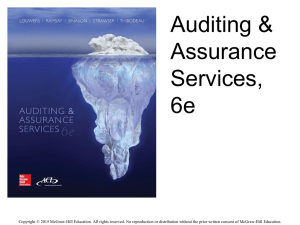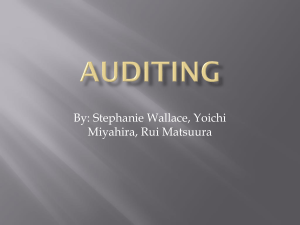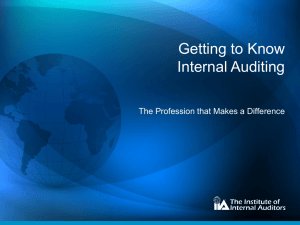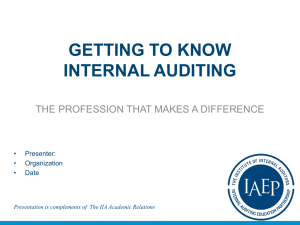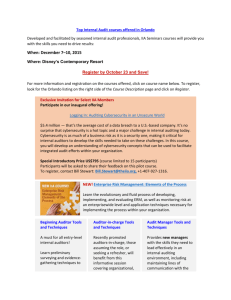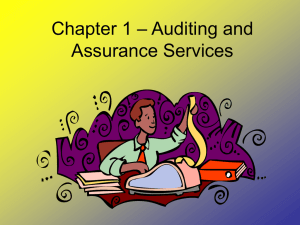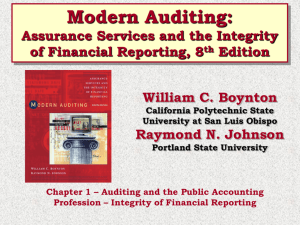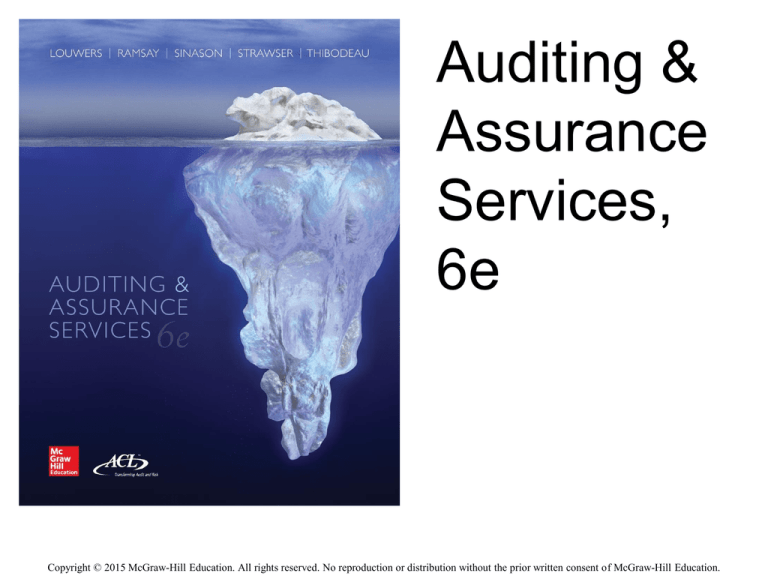
Auditing &
Assurance
Services,
6e
Copyright © 2015 McGraw-Hill Education. All rights reserved. No reproduction or distribution without the prior written consent of McGraw-Hill Education.
Chapter 01
Auditing and Assurance Services
“Our system of capital formation relies upon the confidence of
millions of savers to invest in companies.
The auditor’s opinion is critical to that trust."
-- James R. Doty, Chairman
Public Company Accounting Oversight Board (PCAOB)
1-2
Learning Objectives
•
•
•
•
•
•
•
Define information risk and explain how the financial statement auditing process
helps to reduce this risk, thereby reducing the cost of capital for a company.
Define and contrast financial statement auditing, attestation, and assurance
services.
Describe and define the assertions that management makes about the
recognition, measurement, presentation, and disclosure of the financial
statements and explain why auditors use them as the focal point of the audit.
Define professional skepticism and explain its key characteristics.
Describe the organization of public accounting firms and identify the various
services that they offer.
Describe the audits and auditors in governmental, internal, and operational
auditing.
List and explain the requirements for becoming a certified public accountant
(CPA) and other certifications available to an accounting professional.
1-3
User Demand for Reliable Information
• Today’s information
–
–
–
–
More complex
Demanded by remote users
Demanded in a more timely manner
Has far reaching consequences
• Information risk
– The risk that the information disseminated by a
company will be materially false or misleading.
– Users demand an independent third party assessment of
the information
• Business risk
– The risk that an entity will fail to meet its stated
business objectives
1-4
Definition of Auditing
Financial Statements
(including footnotes)
Persons who rely on
the financial reports
•Creditors
•Investors
Auditing is a systematic process of
objectively obtaining and
evaluating evidence regarding
assertions about economic actions
and events to ascertain the degree
of correspondence between the
assertions and established criteria
GAAP
and communicating the results to
Auditor's Report/
interested users.
Other Reports
Source: American Accounting Association Committee on Basic Auditing Concepts.
1973. A Statement of Basic Auditing Concepts, American Accounting Association
(Sarasota, FL).
1-5
Exhibit 1.1: Overview of Financial
Statement Auditing
1-6
Attestation Engagements
• An attestation engagement - a practitioner is assesses and
reports on “subject matter or an assertion about the subject
matter that is the responsibility of another party.”
• Some financial attestation engagements (other than audits)
• Financial forecasts and projections
• Examination of Management’s Discussion & Analysis
• Pro forma financial information
• Some non-financial attestation engagements
• Effectiveness of internal control systems
• Compliance with environmental regulations
• Sustainability reporting engagements
1-7
Exhibit 1.2: Sustainability Report for UPS
1-8
Assurance Services
• Assurance services are independent professional services
that improve the quality of information, or its context, for
decision makers.
• Examples
• XBRL Reporting
• Information risk assessment
• Customer satisfaction surveys.
• Internal audit outsourcing
1-9
Exhibit 1.4: The Relationships Among
Auditing, Attestation, and Assurance
Engagements
Assurance Services
Attestation Services
Auditing
1-10
Sarbanes-Oxley Act of 2002
Management’s Responsibility For Financial Reporting
•
•
One of its most important provisions clearly indicates that the
management team is responsible for the financial reporting process and
the financial statements.
In fact, Section 302 of the Act states that the key company officials must
certify the financial statements. That is, the company CEO and CFO
must sign a statement indicating:
1.
2.
3.
They have read the financial statements.
They are not aware of any false or misleading statements (or any key
omitted disclosures).
They believe that the financial statements present an accurate picture of
the company’s financial condition.
Source: U.S. Congress, Sarbanes-Oxley Act of 2002, Pub. L. 107-204, 116 Stat/ 745 (2002).
1-11
Management’s Financial
Statement Assertions (PCAOB)
• Existence or occurrence – Assets and liabilities included in
the accounts exist and recorded transactions are valid and have
actually occurred.
• Rights and obligations- Entity has a legal claim on all assets
and revenues reported and has a legal responsibility for all
liabilities and expenses
• Completeness - All balances and transactions have been
recorded in the financial statements
• Valuation or allocation – Assets, liabilities and recorded
transactions have been valued in accordance with GAAP
• Presentation and disclosure – All accounts are presented in
the appropriate place and all information required has been
disclosed in the statements and footnotes.
1-12
Management’s Financial
Statement Assertions (ASB)
Assertions about Events and Transactions
• Occurrence – Events giving rise to transactions are
valid and have taken place
• Completeness and Cutoff - All transactions have
been recorded and are recorded in the appropriate period
• Accuracy – Transactions are recorded at the correct
amount
• Classification – Transactions have been posted to the
proper account
1-13
Management’s Financial
Statement Assertions (ASB)
Assertions about Account Balances
• Existence – Balances include only assets and liabilities that
exist
• Rights and obligations – Entity has legal claim on all
assets and revenues reported and has a legal responsibility for
all liabilities and expenses
• Completeness – Balances include all items that should be
included in accordance with GAAP
• Accuracy and valuation –Balances are reported at the
proper amount in accordance with GAAP
1-14
Management’s Financial
Statement Assertions (ASB)
Assertions about Presentation and Disclosures
• Occurrence and rights and obligations – items presented
have occurred and are either owned by or represent the responsibility
of the entity
• Completeness – the proper disclosures have all been made by the
entity
• Classification and understandability – accounts in the
disclosures have been appropriately grouped and users can
comprehend the disclosures
• Accuracy and valuation – the amounts in the disclosures have
been properly measured and are valued in accordance with GAAP
1-15
Exhibit 1.6: Assertions and their
Relationships to the Financial Statements
1-16
Professional Skepticism
• Refers to an auditor’s questioning mindset towards
representations made by management and evidential matter
gathered
– Inquiry alone is never enough. The auditor must obtain sufficient
corroborative evidence.
– Unusual financial trends need investigation
– Documents are always checked for authenticity or possible alteration
– Ask questions, get answers, then verify the answers.
• Must be skeptical because a potential conflict of interest
always exists between the auditor and the client.
– Management wants to portray the company and its operations in the
best possible light.
– Auditors want to make sure that this portrayal is fair and accurate.
1-17
A Professional Judgment Process
•
•
•
•
•
Clarify the issues and objectives
Consider the possible alternatives
Gather and evaluate the relevant evidence
Reach an audit conclusion
Carefully document rationale for the
professional judgment reached
Source: “Elevating Professional Judgment in Accounting and Auditing: The
KPMG Professional Judgment Framework” (Montvale, NJ: KMPG, 2011).
1-18
The Public Accounting Profession
• Assurance services
•
•
•
•
•
Financial Statement Audit engagements
Assurance engagements
Attestation engagements
Compilations
Reviews
• Tax services
• Consulting and Advisory services
1-19
Exhibit 1.7: Public Accounting Firm
Organization
1-20
Organization of the Profession
• “Big Four” Accounting Firms
– Deloitte, EY, KPMG, PwC
• National
– Grant Thornton, BDO, McGladrey
• Local/Regional
– Melton & Melton (Houston)
– Plante Moran (Michigan/Illinois/Wisconsin)
– Goodman & Company (Virginia)
• Sole Proprietor
1-21
Exhibit 1.8: Revenues for the Big Four
CPA Firms
1-22
Prohibited Professional Services
•
•
•
In summary, Sarbanes-Oxley prohibits professional service firms
from performing any client services for audit clients in which the
auditors may find themselves making management decisions or
auditing their own firm’s work.
Specifically, Sarbanes-Oxley prohibits professional service firms
from providing any of the following services to an audit client:
1) bookkeeping and related services
2) design or implementation of financial information systems
3) appraisal or valuation services
4) actuarial services
5) internal audit outsourcing
6) management or human resources services
7) investment or broker/dealer services
8) legal and expert services (unrelated to the audit)
Professional service firms may provide client tax services (with some
restrictions) and other non-prohibited services to audit clients if the
company’s audit committee has approved them in advance.
1-23
Types of Audits and Auditors
• Financial (External Auditors/CPAs)
• Ensure that financial statements are reliable
• Operational (Internal and Governmental
Auditors/CIAs)
• Improve operational economy
• Improve operational efficiency
• Compliance (Internal and Governmental Auditors)
• Ensure compliance with company and/or governmental rules
and regulations
• Forensic (Fraud Auditors/CFEs)
• Designed to investigate a crime and will often involve
gathering evidence designed to convict a fraudster
1-24
Become Certified!
•
•
•
•
•
Education
Examination
Experience
State Certificate and License
Skills sets and your education
1-25
The CPA Exam
• Significantly Revised in 2011
• Computerized
• 14 Hours - Four parts
–
–
–
–
Auditing and Attestation (AUD)
Financial Accounting and Reporting (FAR)
Regulation (REG)
Business Environment and Concepts (BEC)
• Multiple Choice Questions and Task-Based
Simulations
1-26

